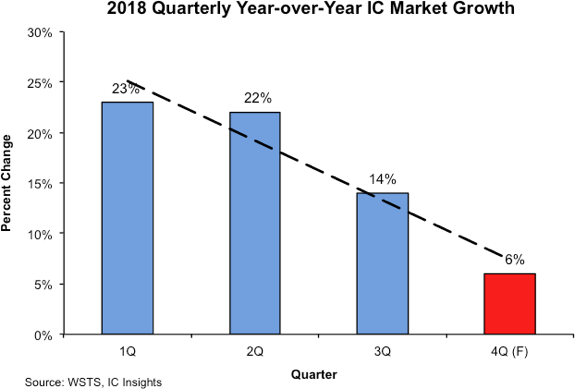- Ameya360 Component Supply Platform >
- Trade news >
- Quarterly Year-over-Year Growth Slows Substantially for IC Market
Quarterly Year-over-Year Growth Slows Substantially for IC Market
Analysis shows decline from 23% year-over-year growth in 1Q18 to 6% forecast for 4Q18.
IC Insights’ November Update to The 2018 McClean Report will present an in-depth analysis and detailed five-year forecast for the IC Industry, which is expected to enter a period of cyclical “cooling” after an extended period of very strong growth.
Figure 1 illustrates the worldwide quarterly year-over-year IC market increases from 1Q through 3Q and IC Insights’ forecast for 4Q of this year. As shown, the first half of 2018 started out with strong quarterly year-over-year growth for the IC market. However, 3Q year-over-year IC market growth dropped to 14%. Moreover, with the softening of the memory market, IC Insights projects that year-over-year IC market growth in 4Q will be only 6%.

Figure 1
Third quarter sequential growth confirms the slowing year-over-year trend. In 2017, 3Q/2Q IC market growth was 11%. This year, 3Q/2Q growth slowed to a 6% increase (the same rate as the long term average). As mentioned, the softening memory market has started to become a “headwind” on total IC market growth. It is interesting that in 2017, the 3Q/2Q memory market growth rate was a very strong 18%. In contrast, the 3Q/2Q memory market increase in 2018 was 8%, less than half of last year’s rate.
Online messageinquiry

Revenue Growth in China's Semiconductor Industry Would Slow Down to 16.2% in 2019 due to Pessimistic
- Week of hot material
- Material in short supply seckilling
| model | brand | Quote |
|---|---|---|
| BD71847AMWV-E2 | ROHM Semiconductor | |
| RB751G-40T2R | ROHM Semiconductor | |
| TL431ACLPR | Texas Instruments | |
| MC33074DR2G | onsemi | |
| CDZVT2R20B | ROHM Semiconductor |
| model | brand | To snap up |
|---|---|---|
| IPZ40N04S5L4R8ATMA1 | Infineon Technologies | |
| ESR03EZPJ151 | ROHM Semiconductor | |
| TPS63050YFFR | Texas Instruments | |
| BP3621 | ROHM Semiconductor | |
| STM32F429IGT6 | STMicroelectronics | |
| BU33JA2MNVX-CTL | ROHM Semiconductor |
- Week of ranking
- Month ranking
Qr code of ameya360 official account
Identify TWO-DIMENSIONAL code, you can pay attention to


Please enter the verification code in the image below:

























